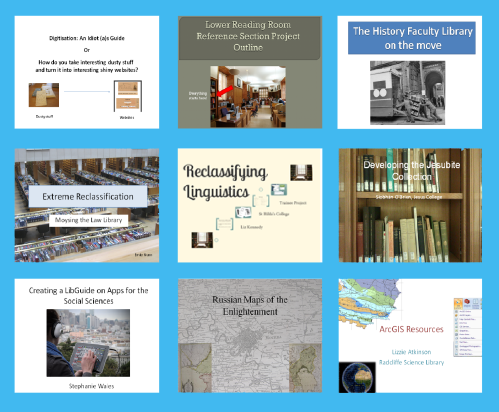On July 4th, Oxford’s contingent of graduate trainees held a showcase to present the projects we had been working on in our libraries. Each year, most of the trainees choose or are given a project to work on alongside our regular duties. These projects often reflect our particular skills or interests, as well as the needs of the library. Towards the end of the year, two of us (this time Natalie and I) organise the showcase event, and most of the trainees give presentations about our progress to an audience of our supervisors, colleagues and fellow trainees.
There were fifteen presentations this year, covering a range of topics. Some projects focussed on creating videos and libguides to help students use resources or find services. Others compared different Oxford libraries’ rules or signage to offer advice about possible improvements. The reclassification projects made collections easier, quicker and less frustrating to browse. Some of us also worked on making specific resources more available by digitising, cataloguing, creating searchable databases or, in one case, physically finding them!
In addition to the presentations, Emma Sullivan gave a short speech about the benefits of projects, both for us as trainees, and for the libraries. We have a chance to develop skills and experience that will be valuable in our future careers, both from the specific content covered, and also from learning how to plan and implement an extended project. The libraries have a chance to get a project completed that will be of lasting benefit to them, which in turn allows us to feel that we are really part of the library.
The presentations were well received, and the event was enjoyed by all (with the exception of pre-presentation nerves…)
Here is a very brief summary, in alphabetical order, of each trainee’s project:
Vicky Arnold (All Souls) managed to track down some 17th century Russian maps mentioned very briefly in the library committee’s minutes, but subsequently lost amid the library’s collections.
Lizzie Atkinson (RSL) created video and libguide resources to showcase what the mapmaking and spatial analysis programme ArcGIS can do, and to help students and researchers decide if they need to use it.
Louise Cowan (St Hugh’s) discovered common factors influencing how frequently students disobey library rules, including whether they see the effect that breaking a rule would have on others.
Rebecca Hunt (EFL) used the University archives to research the EFL’s history, creating a booklet, a display and a facebook timeline in preparation for their centenary in 2014.
Charlotte Kelham (Nuffield) catalogued the architects’ plans for Nuffield College, discovering very different pre- and post- World War Two designs.
Liz Kennedy (St Hilda’s) reclassified the library’s linguistics section, using customised Dewey to fit with the existing system and reflect the level of detail needed.
Rebecca Nielsen (futureArch) investigated how to extract and catalogue the video files stored on an outdated type of camcorder cassette called MiniDV.
Emily Nunn (LawBod) reclassified books and ‘spring-cleaned’ their catalogue records as part of the LawBod’s mass reclassification project to adopt the Moys system, which allows law materials to be browsed by subject.
Siobhan O’Brien (Jesus) established a collection development policy and classification system for the library’s collection of books by and about Jesus members.
Natalie O’Keefe (HFL) made short explanatory videos for students (and staff…) to access online, showing how different services will be provided in the HFL’s new location within the Radcliffe Camera.
Laurence Peacock (Taylor Slavonic) took a collection of letters from an Oxford professor’s trip to Germany in 1913, scanned and catalogued them, then created a website to promote them, including a searchable database of the details and images.
Matthew Pocock (Bodleian) integrated a section of LCC books into the reading room’s existing system, planning and implementing a large book move to accommodate the reclassified books.
Stephanie Wales (SSL) reviewed different iPad apps for the social sciences, creating a lib guide of recommendations.
Janine Walker (SSL) investigated how libraries communicate with their readers, making suggestions about improving signage in the physical library space as well as keeping branding consistent online.
Evelyn Webster (Union Society) designed and began building a searchable database to record information about the Union’s debates, officers and famous speakers.
